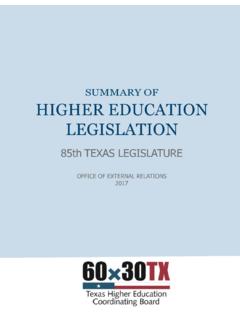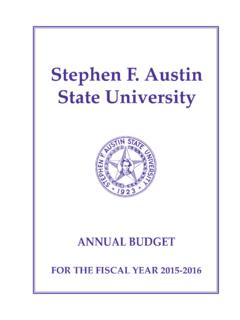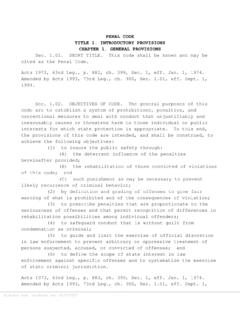Transcription of Texas College and Career Readiness Standards
1 Texas College and Career Readiness StandardsTexas Higher Education Coordinating BoardDivision for P-16 InitiativesCollege Readiness InitiativesPO Box 12788 Austin, TX Education AgencyDivision of CurriculumCollege and Career Readiness Program1701 N. Congress Avenue, Suite 3-121 Austin, TX College and Career Readiness StandardsTexas College and Career Readiness StandardsiTable of ContentsIntroduction ..iiiEnglish/Language Arts Standards ..1 Mathematics Standards ..7 Science Standards ..13 Social Studies Standards ..23 Cross-Disciplinary Standards .
2 29 Glossary of Terms ..33 Vertical Team Members ..38 Appendix ..a1 English/Language Arts Standards with performance indicators ..a3 Mathematics Standards with performance indicators ..a11 Science Standards with performance indicators ..a23 Social Studies Standards with performance indicators ..a49 Cross-Disciplinary Standards with performance indicators ..a59 Texas College and Career Readiness StandardsiiTexas College and Career Readiness StandardsiiiIntroductionOver the past decade, Texas has focused on ensuring that its students are prepared for a changing and increasingly complex future.
3 In elementary and middle schools, test results have improved, especially among students of color, and more students of all backgrounds are entering and completing postsecondary education programs. However, despite these substantial gains, Texas trails other states in preparing and sending students to postsecondary education. It is also clear that K-12 students, along with their parents, are uncertain about what students must know and what intellectual skills they must possess to be successful beyond high school. Recognizing the importance of a world class education, the 79th Texas Legislature, Third Called Special Session, passed House Bill 1, the Advancement of College Readiness in Curriculum.
4 Section of the Texas Education code , seeks to increase the number of students who are College and Career ready when they graduate high school. The legislation required the Texas Education Agency (TEA) and the Texas Higher Education Coordinating Board (THECB) to establish Vertical Teams (VTs) to develop College and Career Readiness Standards (CCRS) in the areas of English/language arts, mathematics, science, and social studies. These Standards specify what students must know and be able to do to succeed in entry-level courses at postsecondary institutions in Texas .
5 Vertical Teams were composed of secondary and postsecondary faculty. In 2007, the VTs met in February, March, June, and August and developed draft Standards to present to the THECB. At its October 2007 meeting, Board members approved posting of the draft Standards for public comment. Over 1500 comments were received and were reviewed by the VTs as they prepared their final drafts. The final drafts were submitted to the Commissioner of Higher Education who presented them to the THECB for adoption at its January 2008 meeting.
6 The CCRS were approved unanimously and sent to the Commissioner of Education and the State Board of Education for incorporation into the Texas Essential Knowledge and Skills (TEKS). The Nature of College and Career Readiness StandardsIn developing the CCRS, the VTs set out to specify the knowledge and skills necessary to succeed in entry-level community College and university courses. The CCRS serve a different purpose than high school graduation Standards , which typically emphasize mastery of basic skills and knowledge, and not necessarily College and Career Readiness .
7 High school courses are designed to provide a broad set of core knowledge and skills and a foundation in literacy and basic mathematics. College courses typically require students to use content knowledge to weigh and analyze important issues and questions in a field of study. Even a high-quality College -preparatory curriculum is unlikely to prepare students to pursue a specific major in College . It can, however, help students develop a foundation of skills that they can employ to successfully pursue a variety of College majors.
8 Therefore, the CCRS distinguish themselves from high school Standards by emphasizing content knowledge as a means to an end: the content stimulates students to engage in deeper levels of thinking. The CCRS are designed to represent a full range of knowledge and skills that students need to succeed in entry-level College courses, as well as in a wide range of majors and careers. According to research, over 80 percent of 21st century jobs require some postsecondary education. By implementing these Standards , secondary school and postsecondary faculty in all academic disciplines will advance the mission of Texas : College and Career ready of the College and Career Readiness Standards FrameworkThe CCRS consist of a multi-level framework that focuses not only on subject matter, but also on the way it is organized and presented in the classroom.
9 This is crucial because at the postsecondary level, students need to understand the structure of the discipline and how knowledge expands from initial study of a topic. This pedagogical understanding sets a threshold for the kinds of deeper investigation and learning that occur as students pursue in-depth courses in their chosen majors. Texas College and Career Readiness StandardsivWithout an adequate understanding of the structure of their discipline, students will have difficulty succeeding in or will get less out of the upper-division courses that they will eventually take.
10 The CCRS, therefore, introduce these disciplinary structures at the entry-level in order to familiarize students with key concepts and content in each of the four subject areas previously specified and in a set of cross-disciplinary Standards . Roman numerals mark the key content within each subject area. Capital letters specify the organizing components for introducing key knowledge and skills. Numbered headings delineate specific performance expectations regarding expected knowledge and skills and also suggest the challenge level of the standard.
















